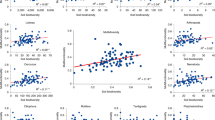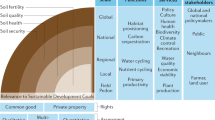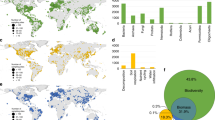Abstract
Soil biodiversity is increasingly recognized as providing benefits to human health because it can suppress disease-causing soil organisms and provide clean air, water and food. Poor land-management practices and environmental change are, however, affecting belowground communities globally, and the resulting declines in soil biodiversity reduce and impair these benefits. Importantly, current research indicates that soil biodiversity can be maintained and partially restored if managed sustainably. Promoting the ecological complexity and robustness of soil biodiversity through improved management practices represents an underutilized resource with the ability to improve human health.
This is a preview of subscription content, access via your institution
Access options
Subscribe to this journal
Receive 51 print issues and online access
$199.00 per year
only $3.90 per issue
Buy this article
- Purchase on Springer Link
- Instant access to full article PDF
Prices may be subject to local taxes which are calculated during checkout


Similar content being viewed by others
References
Bardgett, R. D. & van der Putten, W. H. Belowground biodiversity and ecosystem functioning. Nature 515, 505–511 (2014)
Fisher, F. S., Bultman, M. W., Johnson, S. M., Pappagianis, D. & Zaborsky, E. Coccidioides niches and habitat parameters in the southwestern United States: a matter of scale. Ann. NY Acad. Sci. 1111, 47–72 (2007)
Wall, D. H. et al. Soil Ecology and Ecosystem Services (Oxford Univ. Press, 2012)
Wall, D. H. & Six, J. Give soils their due. Science 347, 695 (2015)
Haddad, N. M. et al. Habitat fragmentation and its lasting impact on Earth’s ecosystems. Sci. Adv. 1, e1500052 (2015)
Tsiafouli, M. A. et al. Intensive agriculture reduces soil biodiversity across Europe. Glob. Change Biol. 21, 973–985 (2015).This study, encompassing four agricultural regions across Europe, showed that increasing land-use intensity reduced soil foodweb diversity, functional diversity and taxonomic diversity.
Garrison, V. H. et al. African and Asian dust: from desert soils to coral reefs. Bioscience 53, 469–480 (2003)
Park, J. W. et al. Effects of ambient particulate matter on peak expiratory flow rates and respiratory symptoms of asthmatics during Asian dust periods in Korea. Respirology 10, 470–476 (2005)
Quinton, J. N., Govers, G., Van Oost, K. & Bardgett, R. D. The impact of agricultural soil erosion on biogeochemical cycling. Nature Geosci. 3, 311–314 (2010)
Schenker, M. Exposures and health effects from inorganic agricultural dusts. Environ. Health Perspect. 108, 661–664 (2000)
Dominati, E., Patterson, M. & Mackay, A. A framework for classifying and quantifying the natural capital and ecosystem services of soils. Ecol. Econ. 69, 1858–1868 (2010)
Thiele-Bruhn, S., Bloem, J., de Vries, F. T., Kalbitz, K. & Wagg, C. Linking soil biodiversity and agricultural soil management. Curr. Opin. Environ. Sustainability 4, 523–528 (2012)
Nielsen, U. N., Wall, D. H. & Six, J. Soil biodiversity and the environment. Annu. Rev. Environ. Resour. 40, 63–90 (2015)
World Health Organization and Secretariat of the Convention on Biological Diversity. Connecting Global Priorities: Biodiversity and Human Health. A State of Knowledge Review https://www.cbd.int/health/SOK-biodiversity-en.pdf (WHO, 2015)
Brevik, E. C. & Burgess, L. C. The 2012 fungal meningitis outbreak in the United States: connections between soils and human health. Soil Horizons 54, 1–4 (2013)
Oliver, M. A. & Gregory, P. J. Soil, food security and human health: a review. Eur. J. Soil Sci. 66, 257–276 (2015)
Ling, L. L. et al. A new antibiotic kills pathogens without detectable resistance. Nature 517, 455–459 (2015)
Ferris, H. & Tuomisto, H. Unearthing the role of biological diversity in soil health. Soil Biol. Biochem. 85, 101–109 (2015)
Brevik, E. C. & Burgess, L. C. Soils and Human Health (CRC Press, 2012)
Bultman, M. W., Fisher, F. S. & Pappagianis, D. in Essentials of Medical Geology (ed. O. Selinus ) Ch. 20 (Springer, 2013)
Pepper, I. L., Gerba, C. P., Newby, D. T. & Rice, C. W. Soil: a public health threat or savior? Crit. Rev. Environ. Sci. Technol. 39, 416–432 (2009)
Brevik, E. C. & Sauer, T. J. The past, present, and future of soils and human health studies. Soil 1, 35–46 (2015)
Myers, S. S. & Patz, J. A. Emerging threats to human health from global environmental change. Annu. Rev. Environ. Resour. 34, 223–252 (2009)
Berg, G., Eberl, L. & Hartmann, A. The rhizosphere as a reservoir for opportunistic human pathogenic bacteria. Environ. Microbiol. 7, 1673–1685 (2005)
Ganz, H. H. et al. Interactions between Bacillus anthracis and plants may promote anthrax transmission. PLoS Negl. Trop. Dis. 8, http://dx.doi.org/10.1371/journal.pntd.0002903 (2014)
Smith, K. L. et al. Bacillus anthracis diversity in Kruger National Park. J. Clin. Microbiol. 38, 3780–3784 (2000)
Schär, F. et al. Strongyloides stercoralis: global distribution and risk factors. PLoS Negl. Trop. Dis. 7, http://dx.doi.org/10.1371/journal.pntd.0002288 (2013)
Khieu, V. et al. High prevalence and spatial distribution of Strongyloides stercoralis in rural Cambodia. PLoS Negl. Trop. Dis. 8, http://dx.doi.org/10.1371/journal.pntd.0002854 (2014)
de Silva, N. R. et al. Soil-transmitted helminth infections: updating the global picture. Trends Parasitol. 19, 547–551 (2003)
Kay, A. B. Overview of “Allergy and allergic diseases: with a view to the future”. Br. Med. Bull. 56, 843–864 (2000)
Matricardi, P. M. & Bonini, S. High microbial turnover rate preventing atopy: a solution to inconsistencies impinging on the hygiene hypothesis? Clin. Exp. Allergy 30, 1506–1510 (2000)
Rook, G. A. W. 99th Dahlem conference on infection, inflammation and chronic inflammatory disorders: Darwinian medicine and the 'hygiene' or 'old friends' hypothesis. Clin. Exp. Immunol. 160, 70–79 (2010)
Hanski, I. et al. Environmental biodiversity, human microbiota, and allergy are interrelated. Proc. Natl Acad. Sci. USA 109, 8334–8339 (2012). This study provides evidence that people living near environmentally diverse areas had less propensity for allergies because of a greater diversity of commensal bacteria on their skin, most of which are also found in soil and vegetation.
Haahtela, T. et al. The Finnish Allergy Programme 2008–2018—scientific rationale and practical implementation. Asia Pacific Allergy 2, 275–279 (2012)
Ruokolainen, L. et al. Green areas around homes reduce atopic sensitization in children. Allergy 70, 195–202 (2015)
Prichard, R. in Antimicrobial Drug Resistance (ed. Mayers, D. L. ) 621–628 (Springer, 2009)
Corbett, C. J. et al. The effectiveness of faecal removal methods of pasture management to control the cyathostomin burden of donkeys. Parasites Vectors 7, 48 (2014)
Epstein, L. Fifty years since Silent Spring. Annu. Rev. Phytopathol. 52, 377–402 (2014)
Campos-Herrera, R., El-Borai, F. E. & Duncan, L. W. in Nematode Pathogenesis of Insects and Other Pests (ed. Campos-Herrera, R. ) (Springer, 2015)
Charles, L. et al. Phylogenetic analysis of Pasteuria penetrans by use of multiple genetic loci. J. Bacteriol. 187, 5700–5708 (2005)
Gray, N. F. Ecology of nematophagous fungi: Panagrellus redivivus as the target organism. Plant Soil 73, 293–297 (1983)
Stirling, G. R. in Biological Control of Plant-Parasitic Nematodes: Building Coherence Between Microbial Ecology and Molecular Mechanisms (eds Davies, K. G. & Spiegel, Y. ) 1–38 (Springer, 2011)
Stirling, G. R. Biological Control of Plant-Parasitic Nematodes: Soil Ecosystem Management Sustainable Agriculture 2nd edn (CABI, 2014)
Costa, S. R., Kerry, B. R., Bardgett, R. D. & Davies, K. G. Interactions between nematodes and their microbial enemies in coastal sand dunes. Oecologia 170, 1053–1066 (2012)
Ferris, H. et al. Diversity and complexity complement apparent competition: nematode assemblages in banana plantations. Acta Oecol. 40, 11–18 (2012)
Sánchez-Moreno, S. & Ferris, H. Suppressive service of the soil food web: effects of environmental management. Agric. Ecosyst. Environ. 119, 75–87 (2007). This study showed that the prevalence of predator and omnivorous nematodes, which suppressed plant parasitic nematodes, was higher in soils with more complex foodwebs.
Penton, C. R. et al. Fungal community structure in disease suppressive soils assessed by 28S LSU gene sequencing. PLoS ONE 9, http://dx.doi.org/10.1371/journal.pone.0093893 (2014)
Weller, D. M., Raaijmakers, J. M., Gardener, B. B. M. & Thomashow, L. S. Microbial populations responsible for specific soil suppressiveness to plant pathogens. Annu. Rev. Phytopathol. 40, 309–348 (2002)
Johnson, P. T. J. et al. Species diversity reduces parasite infection through cross-generational effects on host abundance. Ecology 93, 56–64 (2012)
Johnson, P. T. J., Preston, D. L., Hoverman, J. T. & Richgels, K. L. D. Biodiversity decreases disease through predictable changes in host community competence. Nature 494, 230–233 (2013). This laboratory and field study showed that a richer host diversity reduced transmission of a parasite (the trematode Ribeiroia ondatrae ) and reduced amphibian disease.
Keesing, F., Holt, R. D. & Ostfeld, R. S. Effects of species diversity on disease risk. Ecol. Lett. 9, 485–498 (2006)
Searle, C. L., Biga, L. M., Spatafora, J. W. & Blaustein, A. R. A dilution effect in the emerging amphibian pathogen Batrachochytrium dendrobatidis. Proc. Natl Acad. Sci. USA 108, 16322–16326 (2011)
Suzán, G. et al. Experimental evidence for reduced rodent diversity causing increased hantavirus prevalence. PLoS ONE 4, http://dx.doi.org/10.1371/journal.pone.0005461 (2009)
van Elsas, J. D. et al. Microbial diversity determines the invasion of soil by a bacterial pathogen. Proc. Natl Acad. Sci. USA 109, 1159–1164 (2012). Experimental results showed that in soils with greater microbial diversity invading bacteria have a lower survival rate.
Andersen, D. C. Belowground herbivory in natural communities—a review emphasizing fossorial animals. Q. Rev. Biol. 62, 261–286 (1987)
Gehring, C. A., Wolf, J. E. & Theimer, T. C. Terrestrial vertebrates promote arbuscular mycorrhizal fungal diversity and inoculum potential in a rain forest soil. Ecol. Lett. 5, 540–548 (2002)
Bates, S. T. et al. Global biogeography of highly diverse protistan communities in soil. ISME J. 7, 652–659 (2013)
Wu, T., Ayres, E., Bardgett, R. D., Wall, D. H. & Garey, J. R. Molecular study of worldwide distribution and diversity of soil animals. Proc. Natl Acad. Sci. USA 108, 17720–17725 (2011)
Ramirez, K. S. et al. Biogeographic patterns in below-ground diversity in New York City's Central Park are similar to those observed globally. Proc. R. Soc. B 281, http://dx.doi.org/10.1098/rspb.2014.1988 (2014)
Lauber, C. L., Ramirez, K. S., Aanderud, Z., Lennon, J. & Fierer, N. Temporal variability in soil microbial communities across land-use types. ISME J. 7, 1641–1650https://doi.org/10.1038/ismej.2013.50 (2013)
Tedersoo, L. et al. Global diversity and geography of soil fungi. Science 346, http://dx.doi.org/10.1126/science.1256688 (2014). This analysis indicates that the distribution and species richness of fungi is mostly determined by climate and not related to plant diversity on a global scale, except for root-related ectomycorrizal fungi; biogeographical comparisons of continents indicate efficient dispersal mechanisms for fungi compared to larger organisms.
van Groenigen, J. W. et al. Earthworms increase plant production: a meta-analysis. Sci. Rep. 4, http://dx.doi.org/10.1038/srep06365 (2014)
Evans, T. A., Dawes, T. Z., Ward, P. R. & Lo, N. Ants and termites increase crop yield in a dry climate. Nature Commun. 2, http://dx.doi.org/10.1038/ncomms1257 (2011)
Bender, S. F. & van der Heijden, M. G. A. Soil biota enhance agricultural sustainability by improving crop yield, nutrient uptake and reducing nitrogen leaching losses. J. Appl. Ecol. 52, 228–239 (2015)
de Vries, F. T. et al. Soil food web properties explain ecosystem services across European land use systems. Proc. Natl Acad. Sci. USA 110, 14296–14301 (2013)
de Vries, F. T. et al. Land use alters the resistance and resilience of soil food webs to drought. Nature Clim. Change 2, 276–280 (2012). This study compared nitrogen retention in extensive versus intensive grasslands and showed that species-rich extensively managed grasslands had greater soil nitrogen retention due to a higher fungal:bacterial abundance ratio compared to intensively managed grasslands.
Wall, D. H., Bardgett, R. D. & Kelly, E. F. Biodiversity in the dark. Nature Geosci. 3, 297–298 (2010)
Rillig, M. C. & Mummey, D. L. Mycorrhizas and soil structure. New Phytol. 171, 41–53 (2006)
Schulin, R., Khoshgoftarmanesh, A., Afyuni, M., Nowack, B. & Frossard, E. in Development and Uses of Biofortified Agricultural Products (eds Banuelos, G. S. & Lin, Z.-Q. ) Ch. 6 (CRC Press, 2008)
Rodriguez, R. J. et al. Stress tolerance in plants via habitat-adapted symbiosis. ISME J. 2, 404–416 (2008)
Brown, J. K. M. & Hovmøller, M. S. Epidemiology—aerial dispersal of pathogens on the global and continental scales and its impact on plant disease. Science 297, 537–541 (2002)
Nkem, J. N. et al. Wind dispersal of soil invertebrates in the McMurdo Dry Valleys, Antarctica. Polar Biol. 29, 346–352 (2006)
Madden, N. M., Southard, R. J. & Mitchell, J. P. Conservation tillage reduces PM10 emissions in dairy forage rotations. Atmos. Environ. 42, 3795–3808 (2008)
Sprigg, W. A. et al. Regional dust storm modeling for health services: the case of valley fever. Aeolian Res. 14, 53–73 (2014)
Nguyen, C. et al. Recent advances in our understanding of the environmental, epidemiological, immunological, and clinical dimensions of coccidioidomycosis. Clin. Microbiol. Rev. 26, 505–525 (2013)
Tabor, J. A., O'Rourke, M. K., Lebowitz, M. D. & Harris, R. B. Landscape-epidemiological study design to investigate an environmentally based disease. J. Expo. Sci. Environ. Epidemiol. 21, 197–211 (2011)
Frey, S. D., Elliott, E. T. & Paustian, K. Bacterial and fungal abundance and biomass in conventional and no-tillage agroecosystems along two climatic gradients. Soil Biol. Biochem. 31, 573–585 (1999)
Six, J., Frey, S. D., Thiet, R. K. & Batten, K. M. Bacterial and fungal contributions to carbon sequestration in agroecosystems. Soil Sci. Soc. Am. J. 70, 555–569 (2006)
Anderson, J. O., Thundiyil, J. G. & Stolbach, A. Clearing the air: a review of the effects of particulate matter air pollution on human health. J. Med. Toxicol. 8, 166–175 (2012). This review provides an analysis of the complexity of particulate matter air pollution and its effects on human health.
Nordstrom, K. F. & Hotta, S. Wind erosion from cropland solutions in the USA: a review of problems, and prospects. Geoderma 121, 157–167 (2004)
Alavanja, M. C. R., Ross, M. K. & Bonner, M. R. Increased cancer burden among pesticide applicators and others due to pesticide exposure. CA Cancer J. Clin. 63, 120–142 (2013)
Frankenberger, W. T. & Arshad, M. Bioremediation of selenium-contaminated sediments and water. Biofactors 14, 241–254 (2001)
Abraham, J. & Silambarasan, S. Biodegradation of chlorpyrifos and its hydrolyzing metabolite 3,5,6-trichloro-2-pyridinol by Sphingobacterium sp JAS3. Process Biochem. 48, 1559–1564 (2013)
Rayu, S., Karpouzas, D. G. & Singh, B. K. Emerging technologies in bioremediation: constraints and opportunities. Biodegradation 23, 917–926 (2012)
Bailey, R. T., Romero, E. C. & Gates, T. K. Assessing best management practices for remediation of selenium loading in groundwater to streams in an irrigated region. J. Hydrol. 521, 341–359 (2015)
Tiemann, L., Grandy, A., Atkinson, E., Marin-Spiotta, E. & McDaniel, M. Crop rotational diversity enhances belowground communities and functions in an agrosystem. Ecol. Lett. 18, 761–771 (2015)
Chauvat, M., Titsch, D., Zaytsev, A. S. & Wolters, V. Changes in soil faunal assemblages during conversion from pure to mixed forest stands. For. Ecol. Manage. 262, 317–324 (2011)
Cary, S. C. & Fierer, N. The importance of sample archiving in microbial ecology. Nature Rev. Microbiol. 12, 789–790 (2014)
Jeffery, S. & van der Putten, W. H. Soil-Borne Human Diseases 1–56, http://dx.doi.org/10.2788/37199 (Joint Research Centre Scientific and Technical Reports, European Commission, 2011)
United Nations Sustainable Development Goals. Open Working Group Proposal for Sustainable Development Goals, https://sustainabledevelopment.un.org/focussdgs.html (UN, 2014)
Acknowledgements
We appreciate the encouragement of J. Lehmann to write this article, and acknowledge the comments of B. Adams, L. Duncan, A. Franco, T. Fraser, M. Knox, K. Pintauro, A. Shaw, A. Weller and S. Vandewoude. D.H.W. acknowledges the Winslow Foundation.
Author information
Authors and Affiliations
Contributions
D.H.W., J.S. and U.N.N. contributed equally to the planning and writing of the manuscript.
Corresponding author
Ethics declarations
Competing interests
The authors declare no competing financial interests.
PowerPoint slides
Rights and permissions
About this article
Cite this article
Wall, D., Nielsen, U. & Six, J. Soil biodiversity and human health. Nature 528, 69–76 (2015). https://doi.org/10.1038/nature15744
Received:
Accepted:
Published:
Issue Date:
DOI: https://doi.org/10.1038/nature15744
This article is cited by
-
Erosion and deposition significantly affect the microbial diversity, co-occurrence network, and multifunctionality in agricultural soils of Northeast China
Journal of Soils and Sediments (2024)
-
Multi-round recycling of green waste for the production of iron nanoparticles: synthesis, characterization, and prospects in remediation
Discover Nano (2023)
-
Land use modification causes slow, but predictable, change in soil microbial community composition and functional potential
Environmental Microbiome (2023)
-
Soil horizons regulate bacterial community structure and functions in Dabie Mountain of the East China
Scientific Reports (2023)
-
Soil microbiomes and one health
Nature Reviews Microbiology (2023)
Comments
By submitting a comment you agree to abide by our Terms and Community Guidelines. If you find something abusive or that does not comply with our terms or guidelines please flag it as inappropriate.



